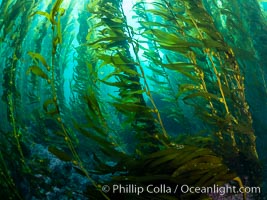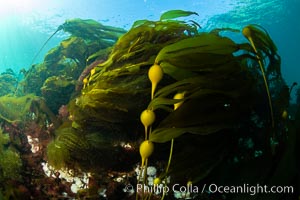
Bull kelp forest near Vancouver Island and Queen Charlotte Strait, Browning Pass, Canada.
Species: Bull kelp, Nereocystis luetkeana
Location: British Columbia, Canada
Image ID: 35337
Species: Bull kelp, Nereocystis luetkeana
Location: British Columbia, Canada
Image ID: 35337
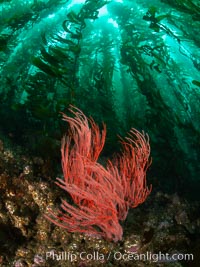
Red gorgonian on rocky reef, below kelp forest, underwater. The red gorgonian is a filter-feeding temperate colonial species that lives on the rocky bottom at depths between 50 to 200 feet deep. Gorgonians are oriented at right angles to prevailing water currents to capture plankton drifting by.
Species: Red gorgonian, Leptogorgia chilensis, Lophogorgia chilensis
Location: Santa Barbara Island, California
Image ID: 35825
Species: Red gorgonian, Leptogorgia chilensis, Lophogorgia chilensis
Location: Santa Barbara Island, California
Image ID: 35825
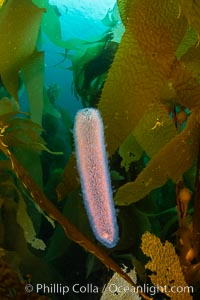
Pyrosome in Kelp Forest, Santa Barbara Island.
Species: Pyrosome, Pyrosoma
Location: Santa Barbara Island, California
Image ID: 35826
Species: Pyrosome, Pyrosoma
Location: Santa Barbara Island, California
Image ID: 35826
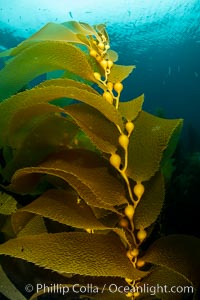
Kelp fronds showing pneumatocysts, bouyant gas-filled bubble-like structures which float the kelp plant off the ocean bottom toward the surface, where it will spread to form a roof-like canopy.
Location: Santa Barbara Island, California
Image ID: 35827
Location: Santa Barbara Island, California
Image ID: 35827
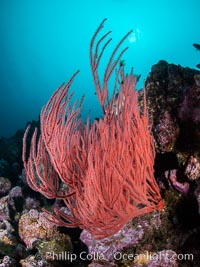
Red gorgonian on rocky reef, below kelp forest, underwater. The red gorgonian is a filter-feeding temperate colonial species that lives on the rocky bottom at depths between 50 to 200 feet deep. Gorgonians are oriented at right angles to prevailing water currents to capture plankton drifting by.
Species: Red gorgonian, Leptogorgia chilensis, Lophogorgia chilensis
Location: Santa Barbara Island, California
Image ID: 35828
Species: Red gorgonian, Leptogorgia chilensis, Lophogorgia chilensis
Location: Santa Barbara Island, California
Image ID: 35828
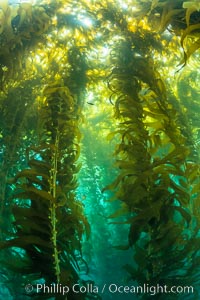
Sunlight glows throughout a giant kelp forest. Giant kelp, the fastest growing plant on Earth, reaches from the rocky reef to the ocean's surface like a submarine forest.
Species: Giant kelp, Macrocystis pyrifera
Location: San Clemente Island, California
Image ID: 37086
Species: Giant kelp, Macrocystis pyrifera
Location: San Clemente Island, California
Image ID: 37086
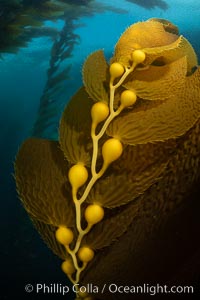
Kelp fronds and pneumatocysts. Pneumatocysts, gas-filled bladders, float the kelp plant off the ocean bottom toward the surface and sunlight, where the leaf-like blades and stipes of the kelp plant grow fastest. Giant kelp can grow up to 2' in a single day given optimal conditions. Epic submarine forests of kelp grow throughout California's Southern Channel Islands.
Species: Giant kelp, Macrocystis pyrifera
Location: San Clemente Island, California
Image ID: 37100
Species: Giant kelp, Macrocystis pyrifera
Location: San Clemente Island, California
Image ID: 37100
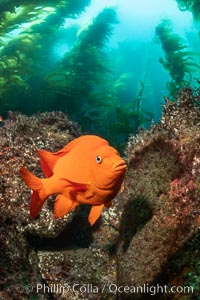
Garibaldi maintains a patch of algae (just in front of the fish) to entice a female to lay a clutch of eggs.
Image ID: 37144
Image ID: 37144
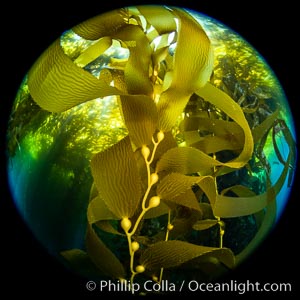
Kelp fronds and pneumatocysts, giant kelp forest, Catalina Island.
Location: Catalina Island, California
Image ID: 37193
Location: Catalina Island, California
Image ID: 37193
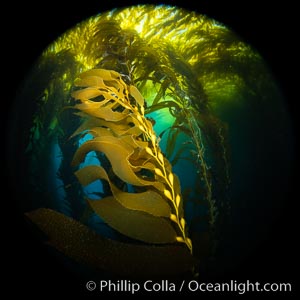
Kelp fronds and pneumatocysts, giant kelp forest, Catalina Island.
Location: Catalina Island, California
Image ID: 37199
Location: Catalina Island, California
Image ID: 37199
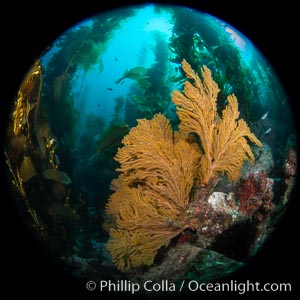
Golden gorgonian on underwater rocky reef, amid kelp forest, Catalina Island.
Species: California golden gorgonian, Muricea californica
Location: Catalina Island, California
Image ID: 37256
Species: California golden gorgonian, Muricea californica
Location: Catalina Island, California
Image ID: 37256
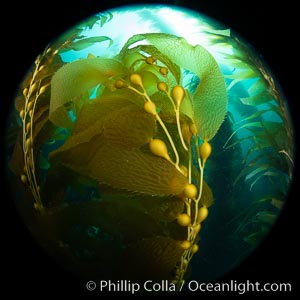
Kelp fronds and pneumatocysts. Pneumatocysts, gas-filled bladders, float the kelp off the ocean bottom toward the surface and sunlight, where the leaf-like blades and stipes of the kelp plant grow fastest.
Species: Giant kelp, Macrocystis pyrifera
Location: Catalina Island, California
Image ID: 37297
Species: Giant kelp, Macrocystis pyrifera
Location: Catalina Island, California
Image ID: 37297
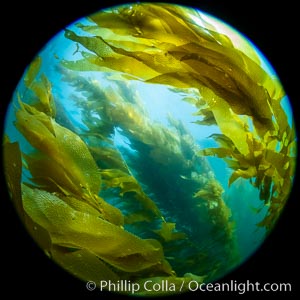
Giant Kelp Forest, West End Catalina Island.
Species: Giant kelp, Macrocystis pyrifera
Location: Catalina Island, California
Image ID: 37300
Species: Giant kelp, Macrocystis pyrifera
Location: Catalina Island, California
Image ID: 37300
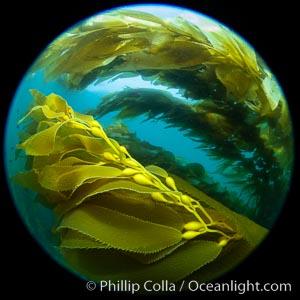
Giant Kelp Forest, West End Catalina Island.
Species: Giant kelp, Macrocystis pyrifera
Location: Catalina Island, California
Image ID: 37301
Species: Giant kelp, Macrocystis pyrifera
Location: Catalina Island, California
Image ID: 37301
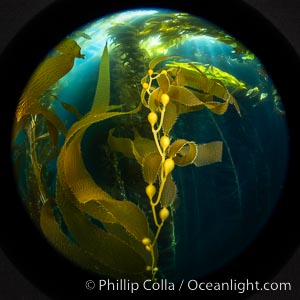
Giant Kelp Forest, West End Catalina Island, rendered in the round by a circular fisheye lens.
Location: Catalina Island, California
Image ID: 38480
Location: Catalina Island, California
Image ID: 38480
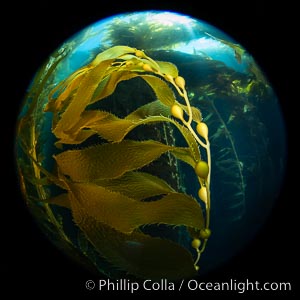
Giant Kelp Forest, West End Catalina Island, rendered in the round by a circular fisheye lens.
Location: Catalina Island, California
Image ID: 38481
Location: Catalina Island, California
Image ID: 38481
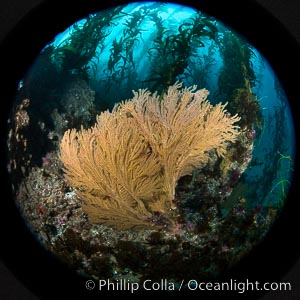
Garibaldi and California golden gorgonian on underwater rocky reef, San Clemente Island. The golden gorgonian is a filter-feeding temperate colonial species that lives on the rocky bottom at depths between 50 to 200 feet deep. Each individual polyp is a distinct animal, together they secrete calcium that forms the structure of the colony. Gorgonians are oriented at right angles to prevailing water currents to capture plankton drifting by.
Species: California golden gorgonian, Giant kelp, Muricea californica, Macrocystis pyrifera
Location: San Clemente Island, California
Image ID: 38501
Species: California golden gorgonian, Giant kelp, Muricea californica, Macrocystis pyrifera
Location: San Clemente Island, California
Image ID: 38501
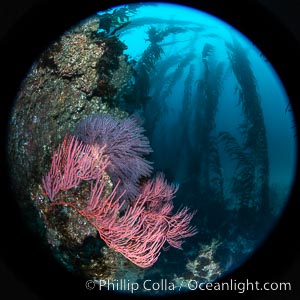
Red gorgonian on rocky reef, below kelp forest, underwater. The red gorgonian is a filter-feeding temperate colonial species that lives on the rocky bottom at depths between 50 to 200 feet deep. Gorgonians are typically oriented at right angles to prevailing water currents to capture plankton drifting by.
Species: Red gorgonian, Giant kelp, Brown gorgonian, Leptogorgia chilensis, Lophogorgia chilensis, Macrocystis pyrifera, Muricea fruticosa
Location: San Clemente Island, California
Image ID: 38502
Species: Red gorgonian, Giant kelp, Brown gorgonian, Leptogorgia chilensis, Lophogorgia chilensis, Macrocystis pyrifera, Muricea fruticosa
Location: San Clemente Island, California
Image ID: 38502
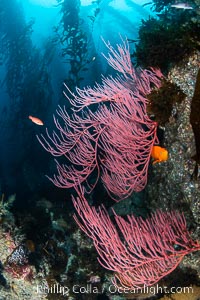
Red gorgonian on rocky reef, below kelp forest, underwater. The red gorgonian is a filter-feeding temperate colonial species that lives on the rocky bottom at depths between 50 to 200 feet deep. Gorgonians are typically oriented at right angles to prevailing water currents to capture plankton drifting by.
Species: Red gorgonian, Giant kelp, Leptogorgia chilensis, Lophogorgia chilensis, Macrocystis pyrifera
Location: San Clemente Island, California
Image ID: 38503
Species: Red gorgonian, Giant kelp, Leptogorgia chilensis, Lophogorgia chilensis, Macrocystis pyrifera
Location: San Clemente Island, California
Image ID: 38503
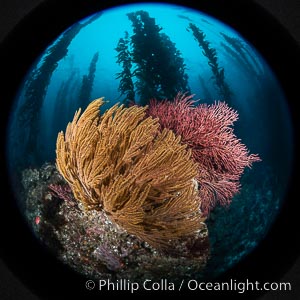
Garibaldi and California golden gorgonian on underwater rocky reef, San Clemente Island. The golden gorgonian is a filter-feeding temperate colonial species that lives on the rocky bottom at depths between 50 to 200 feet deep. Each individual polyp is a distinct animal, together they secrete calcium that forms the structure of the colony. Gorgonians are oriented at right angles to prevailing water currents to capture plankton drifting by.
Species: California golden gorgonian, Giant kelp, Muricea californica, Macrocystis pyrifera
Location: San Clemente Island, California
Image ID: 38504
Species: California golden gorgonian, Giant kelp, Muricea californica, Macrocystis pyrifera
Location: San Clemente Island, California
Image ID: 38504
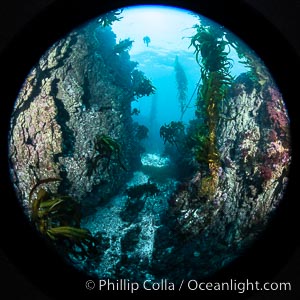
Spectacular underwater rocky reef topography at San Clemente Island, typified by crevices, walls and profuse vertical relief on the rocky ocean bottom below the kelp forest.
Location: San Clemente Island, California
Image ID: 38505
Location: San Clemente Island, California
Image ID: 38505
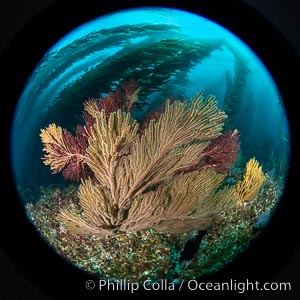
Garibaldi and California golden gorgonian on underwater rocky reef, San Clemente Island. The golden gorgonian is a filter-feeding temperate colonial species that lives on the rocky bottom at depths between 50 to 200 feet deep. Each individual polyp is a distinct animal, together they secrete calcium that forms the structure of the colony. Gorgonians are oriented at right angles to prevailing water currents to capture plankton drifting by.
Species: California golden gorgonian, Giant kelp, Muricea californica, Macrocystis pyrifera
Location: San Clemente Island, California
Image ID: 38509
Species: California golden gorgonian, Giant kelp, Muricea californica, Macrocystis pyrifera
Location: San Clemente Island, California
Image ID: 38509
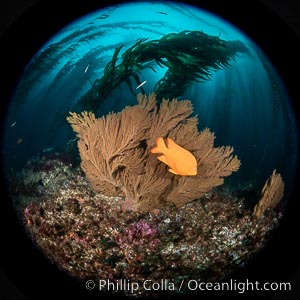
Garibaldi and California golden gorgonian on underwater rocky reef, San Clemente Island. The golden gorgonian is a filter-feeding temperate colonial species that lives on the rocky bottom at depths between 50 to 200 feet deep. Each individual polyp is a distinct animal, together they secrete calcium that forms the structure of the colony. Gorgonians are oriented at right angles to prevailing water currents to capture plankton drifting by.
Species: California golden gorgonian, Giant kelp, Garibaldi, Muricea californica, Macrocystis pyrifera, Hypsypops rubicundus
Location: San Clemente Island, California
Image ID: 38510
Species: California golden gorgonian, Giant kelp, Garibaldi, Muricea californica, Macrocystis pyrifera, Hypsypops rubicundus
Location: San Clemente Island, California
Image ID: 38510
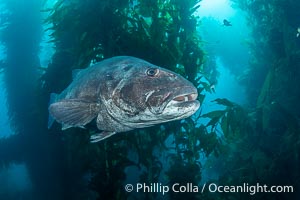
Giant Black Sea Bass with Distinctive Identifying Black Spots that allow researchers to carry out sight/resight studies on the animals distributions and growth. Black sea bass can reach 500 pounds and 8 feet in length.
Species: Giant black sea bass, Stereolepis gigas
Location: Catalina Island, California
Image ID: 39437
Species: Giant black sea bass, Stereolepis gigas
Location: Catalina Island, California
Image ID: 39437
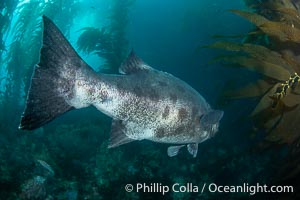
Broad Tail of a Black Sea Bass in the California Kelp Forest showing distinctive unique black spots that allow researchers to identify individual giant sea bass.
Species: Giant black sea bass, Stereolepis gigas
Location: Catalina Island, California
Image ID: 39438
Species: Giant black sea bass, Stereolepis gigas
Location: Catalina Island, California
Image ID: 39438
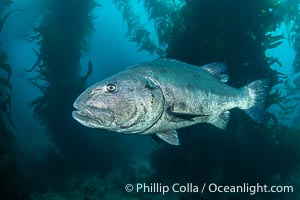
Giant black sea bass in the kelp forest at Catalina Island. An Endangered Giant Sea Bass can reach up to 8 feet in length and 500 pounds, seen here amid the giant kelp forest of Catalina Island. Once nearly fished to extinction and now thought to be at risk of a genetic bottleneck, the giant sea bass is slowly recovering and can be seen in summer months in California's kelp forests.
Species: Giant black sea bass, Stereolepis gigas
Location: Catalina Island, California
Image ID: 39439
Species: Giant black sea bass, Stereolepis gigas
Location: Catalina Island, California
Image ID: 39439
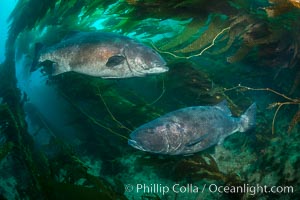
Two giant black sea bass swim in a courtship circle, part of a larger gathering of a mating aggregation amid kelp forest, Catalina Island. In summer months, black seabass gather in kelp forests in California to form mating aggregations. Courtship behaviors include circling of pairs of giant sea bass, production of booming sounds by presumed males, and nudging of females by males in what is though to be an effort to encourage spawning.
Species: Giant black sea bass, Stereolepis gigas
Location: Catalina Island, California
Image ID: 33357
Species: Giant black sea bass, Stereolepis gigas
Location: Catalina Island, California
Image ID: 33357
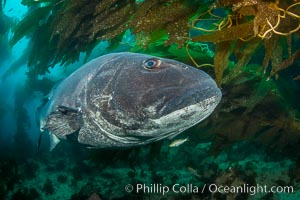
An Endangered Giant Sea Bass can reach up to 8 feet in length and 500 pounds, seen here amid the giant kelp forest of Catalina Island.
Species: Giant black sea bass, Stereolepis gigas
Location: Catalina Island, California
Image ID: 33358
Species: Giant black sea bass, Stereolepis gigas
Location: Catalina Island, California
Image ID: 33358
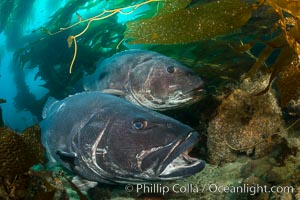
Giant black sea bass, gathering in a mating - courtship aggregation amid kelp forest, Catalina Island.
Species: Giant black sea bass, Stereolepis gigas
Location: Catalina Island, California
Image ID: 33359
Species: Giant black sea bass, Stereolepis gigas
Location: Catalina Island, California
Image ID: 33359
